FORD FREESTYLE 2008 Owners Manual
Manufacturer: FORD, Model Year: 2008, Model line: FREESTYLE, Model: FORD FREESTYLE 2008Pages: 352, PDF Size: 3.2 MB
Page 201 of 352

2. Pull down on the shoulder belt
and then grasp the shoulder belt
and lap belt together.
3. While holding the shoulder and
lap belt portions together, route the
tongue through the child seat
according to the child seat
manufacturer’s instructions. Be sure
the belt webbing is not twisted.
4. Insert the belt tongue into the
proper buckle (the buckle closest to
the direction the tongue is coming
from) for that seating position until
you hear a snap and feel the latch
engage. Make sure the tongue is
latched securely by pulling on it.
2008 Taurus X(219)
Owners Guide (post-2002-fmt)
USA(fus)
Seating and Safety Restraints
201
ProCarManuals.com
Page 202 of 352
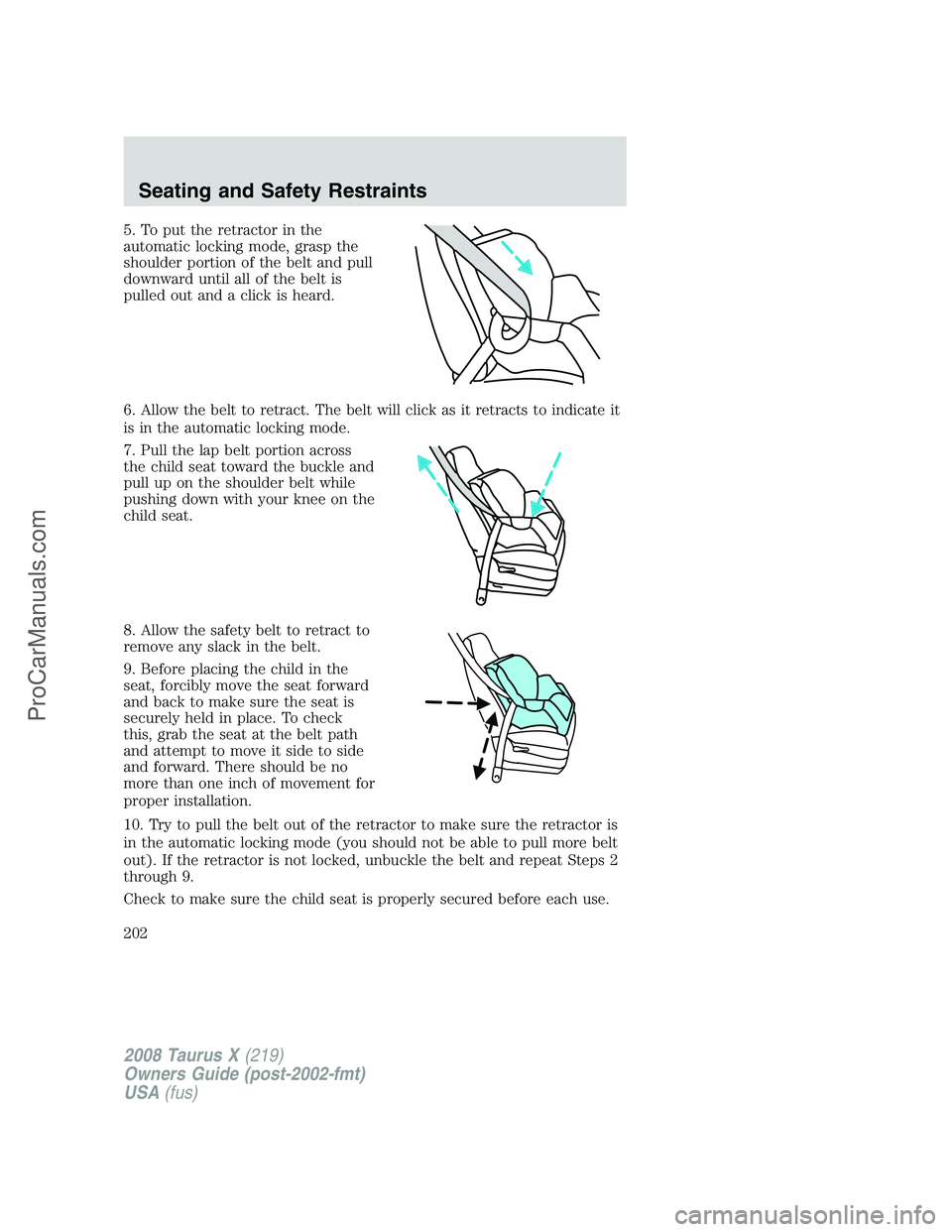
5. To put the retractor in the
automatic locking mode, grasp the
shoulder portion of the belt and pull
downward until all of the belt is
pulled out and a click is heard.
6. Allow the belt to retract. The belt will click as it retracts to indicate it
is in the automatic locking mode.
7. Pull the lap belt portion across
the child seat toward the buckle and
pull up on the shoulder belt while
pushing down with your knee on the
child seat.
8. Allow the safety belt to retract to
remove any slack in the belt.
9. Before placing the child in the
seat, forcibly move the seat forward
and back to make sure the seat is
securely held in place. To check
this, grab the seat at the belt path
and attempt to move it side to side
and forward. There should be no
more than one inch of movement for
proper installation.
10. Try to pull the belt out of the retractor to make sure the retractor is
in the automatic locking mode (you should not be able to pull more belt
out). If the retractor is not locked, unbuckle the belt and repeat Steps 2
through 9.
Check to make sure the child seat is properly secured before each use.
2008 Taurus X(219)
Owners Guide (post-2002-fmt)
USA(fus)
Seating and Safety Restraints
202
ProCarManuals.com
Page 203 of 352
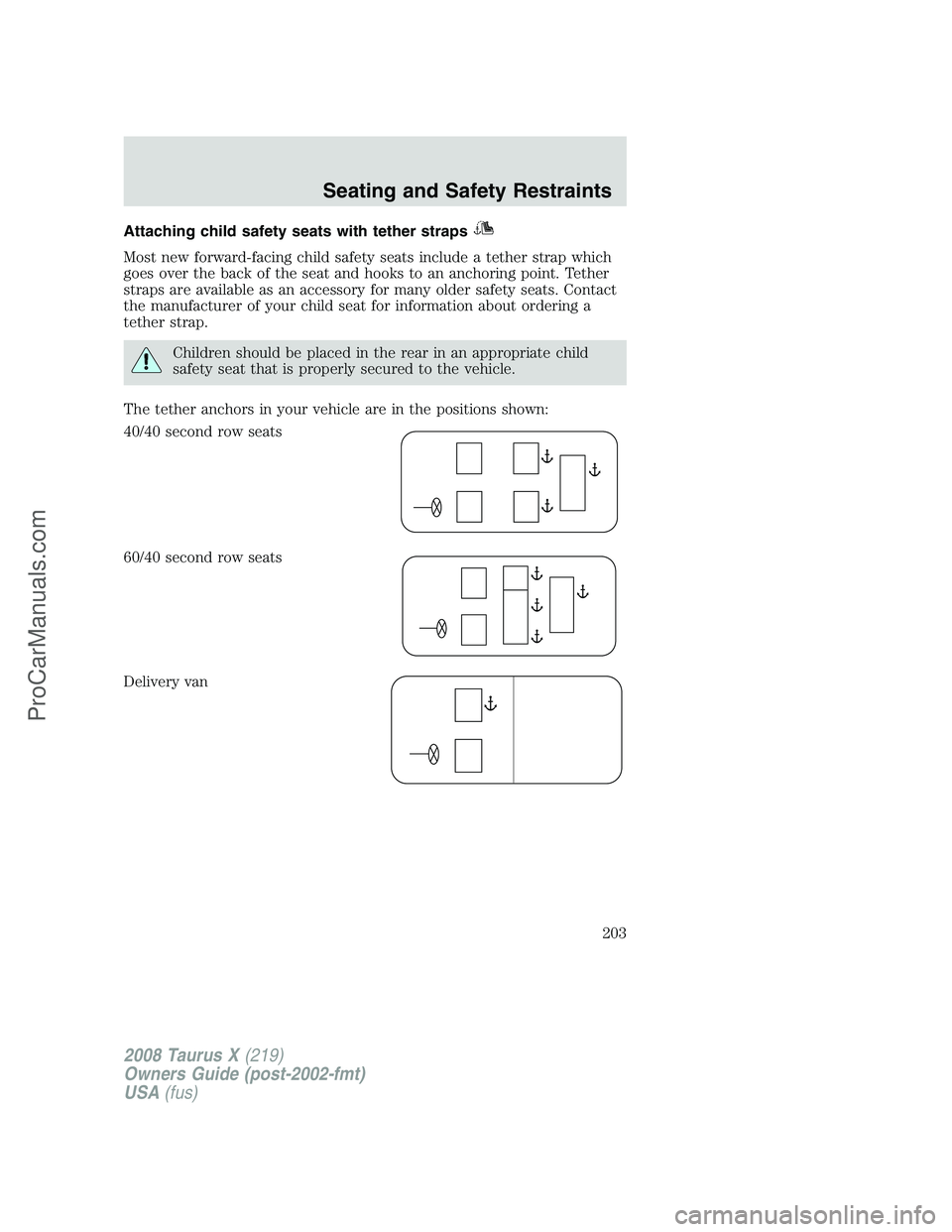
Attaching child safety seats with tether straps
Most new forward-facing child safety seats include a tether strap which
goes over the back of the seat and hooks to an anchoring point. Tether
straps are available as an accessory for many older safety seats. Contact
the manufacturer of your child seat for information about ordering a
tether strap.
Children should be placed in the rear in an appropriate child
safety seat that is properly secured to the vehicle.
The tether anchors in your vehicle are in the positions shown:
40/40 second row seats
60/40 second row seats
Delivery van
2008 Taurus X(219)
Owners Guide (post-2002-fmt)
USA(fus)
Seating and Safety Restraints
203
ProCarManuals.com
Page 204 of 352
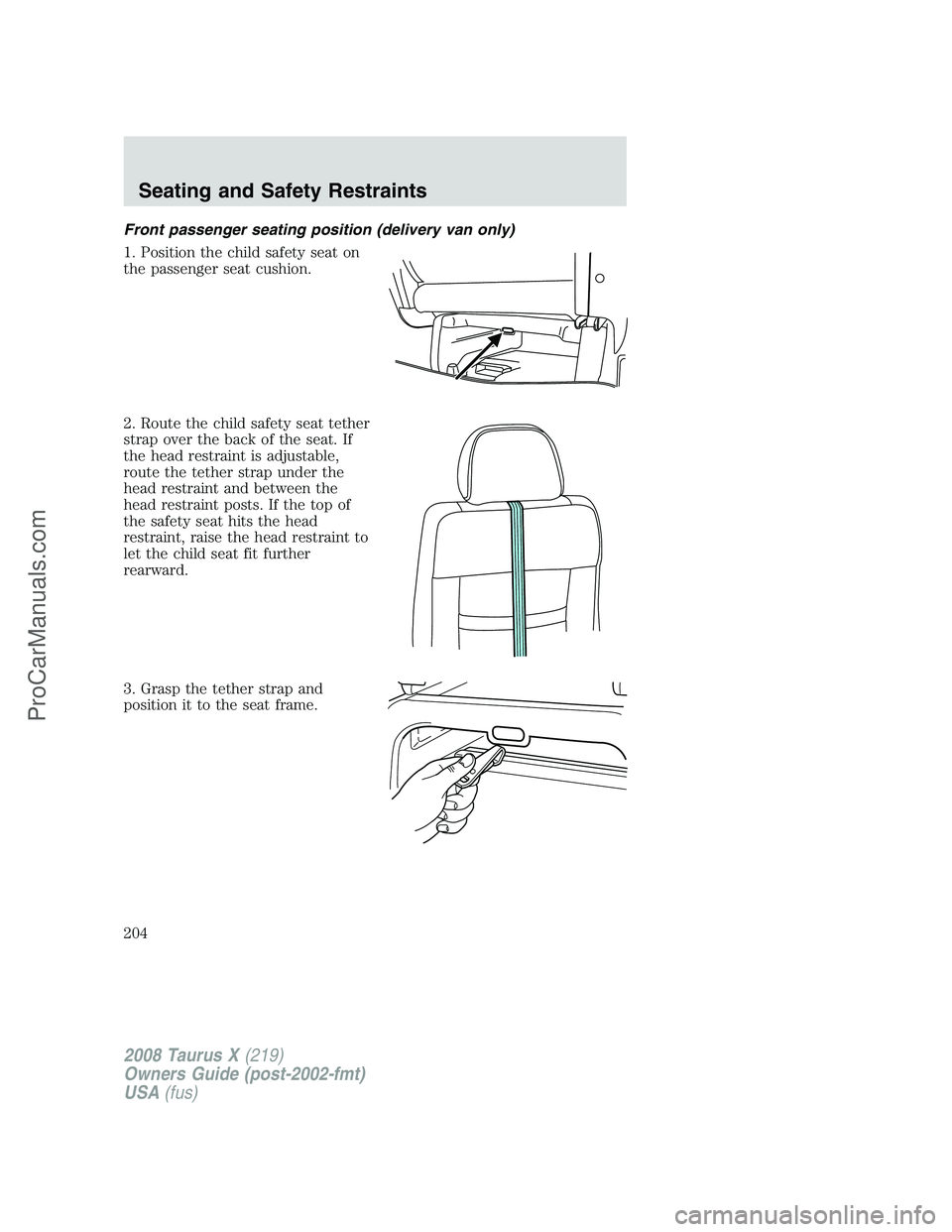
Front passenger seating position (delivery van only)
1. Position the child safety seat on
the passenger seat cushion.
2. Route the child safety seat tether
strap over the back of the seat. If
the head restraint is adjustable,
route the tether strap under the
head restraint and between the
head restraint posts. If the top of
the safety seat hits the head
restraint, raise the head restraint to
let the child seat fit further
rearward.
3. Grasp the tether strap and
position it to the seat frame.
2008 Taurus X(219)
Owners Guide (post-2002-fmt)
USA(fus)
Seating and Safety Restraints
204
ProCarManuals.com
Page 205 of 352
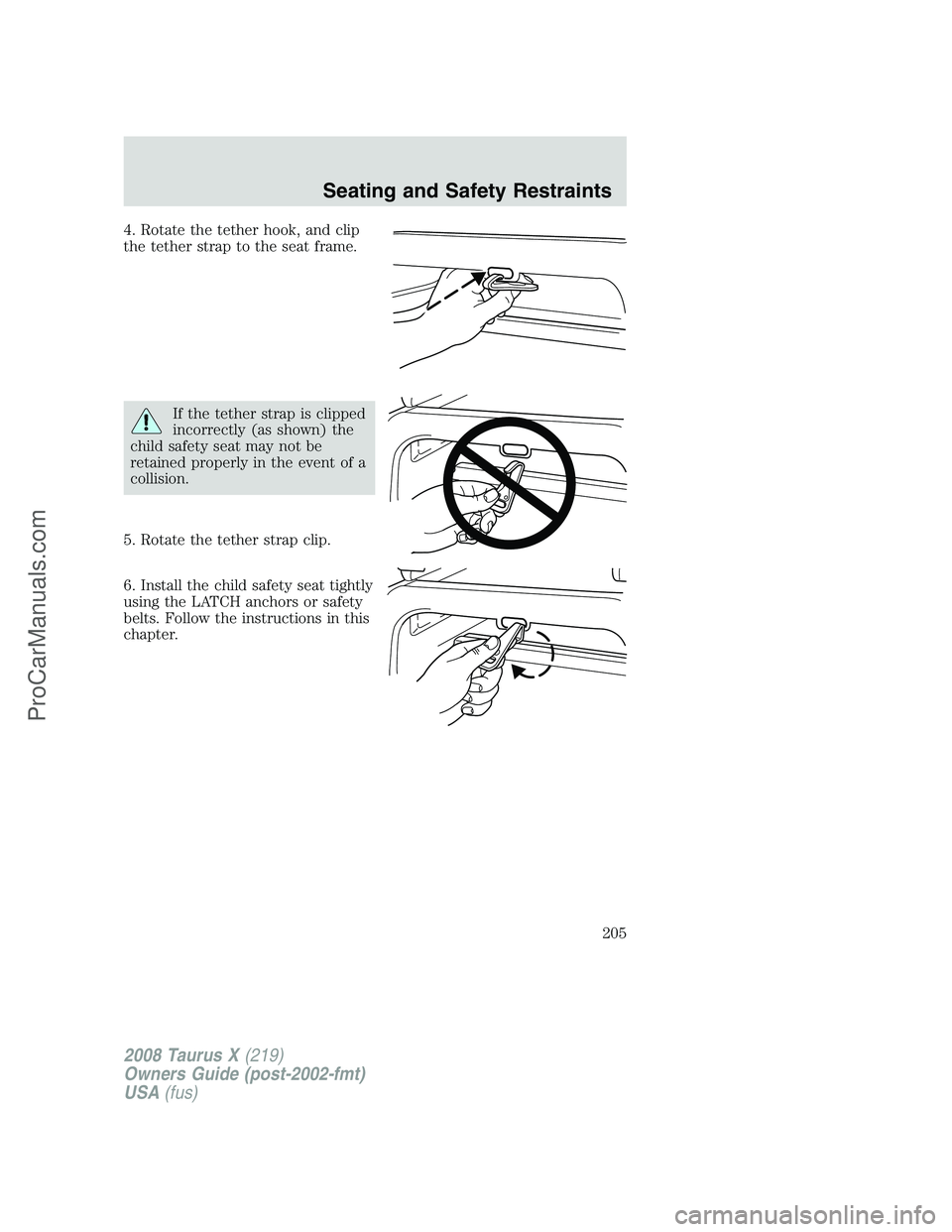
4. Rotate the tether hook, and clip
the tether strap to the seat frame.
If the tether strap is clipped
incorrectly (as shown) the
child safety seat may not be
retained properly in the event of a
collision.
5. Rotate the tether strap clip.
6. Install the child safety seat tightly
using the LATCH anchors or safety
belts. Follow the instructions in this
chapter.
2008 Taurus X(219)
Owners Guide (post-2002-fmt)
USA(fus)
Seating and Safety Restraints
205
ProCarManuals.com
Page 206 of 352
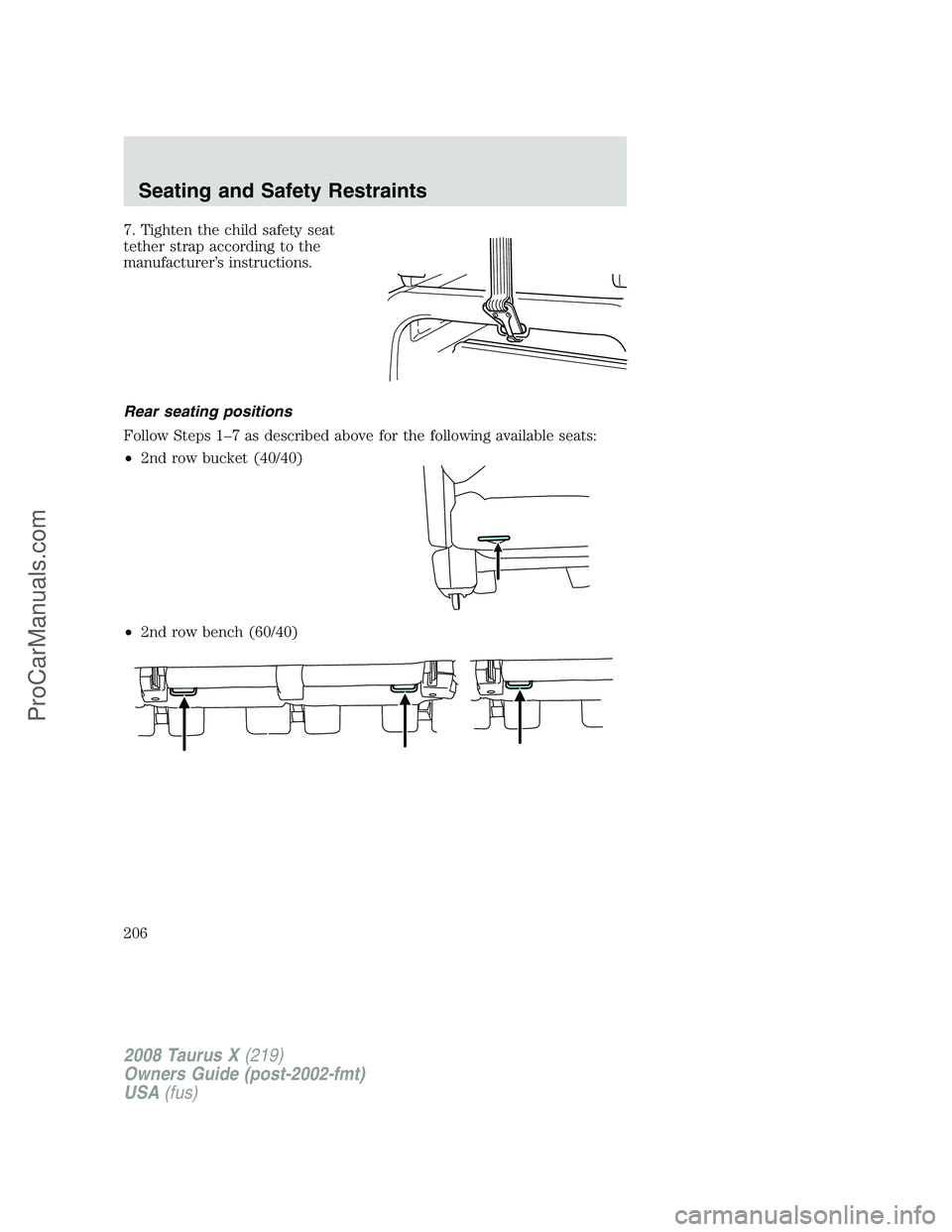
7. Tighten the child safety seat
tether strap according to the
manufacturer’s instructions.
Rear seating positions
Follow Steps 1–7 as described above for the following available seats:
•2nd row bucket (40/40)
•2nd row bench (60/40)
2008 Taurus X(219)
Owners Guide (post-2002-fmt)
USA(fus)
Seating and Safety Restraints
206
ProCarManuals.com
Page 207 of 352
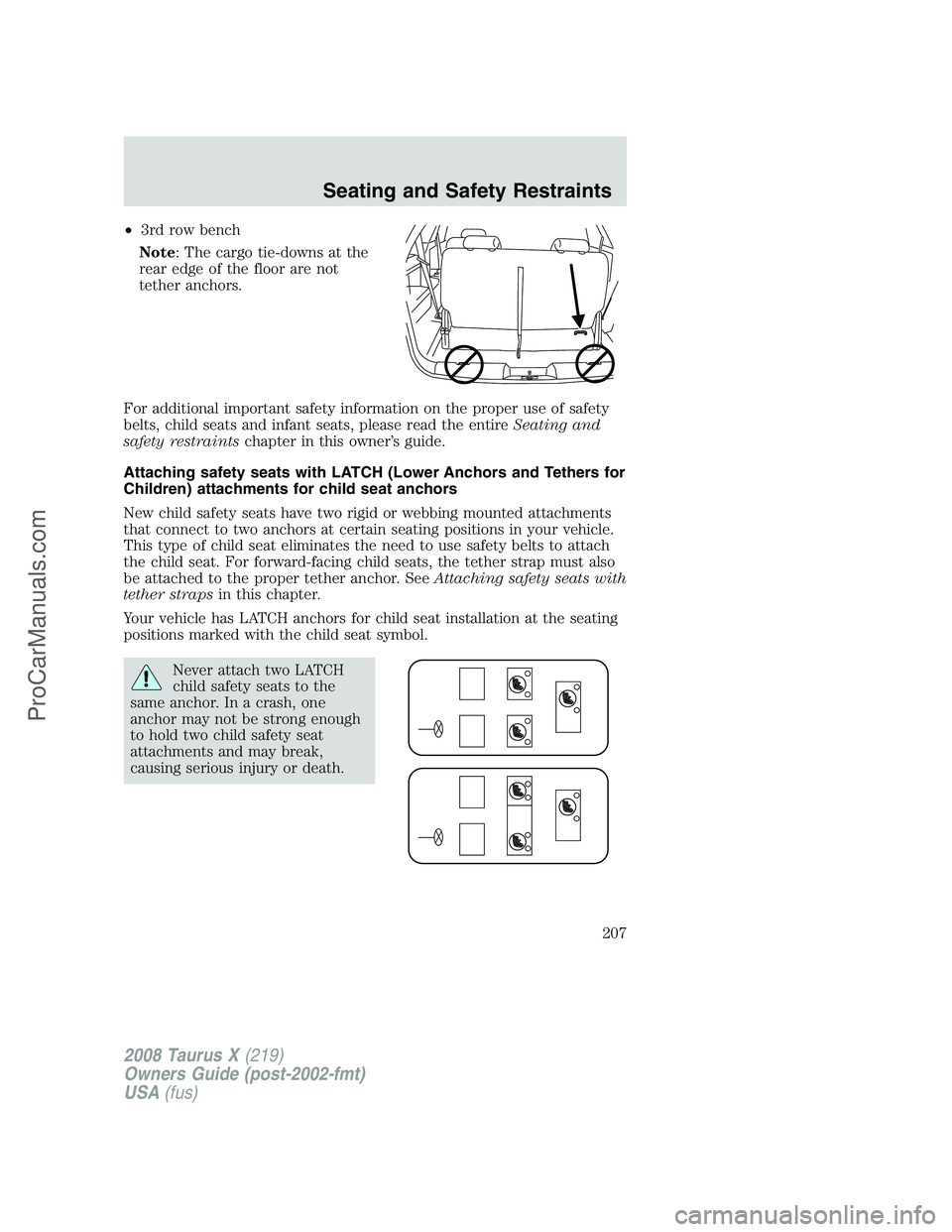
•3rd row bench
Note: The cargo tie-downs at the
rear edge of the floor are not
tether anchors.
For additional important safety information on the proper use of safety
belts, child seats and infant seats, please read the entireSeating and
safety restraintschapter in this owner’s guide.
Attaching safety seats with LATCH (Lower Anchors and Tethers for
Children) attachments for child seat anchors
New child safety seats have two rigid or webbing mounted attachments
that connect to two anchors at certain seating positions in your vehicle.
This type of child seat eliminates the need to use safety belts to attach
the child seat. For forward-facing child seats, the tether strap must also
be attached to the proper tether anchor. SeeAttaching safety seats with
tether strapsin this chapter.
Your vehicle has LATCH anchors for child seat installation at the seating
positions marked with the child seat symbol.
Never attach two LATCH
child safety seats to the
same anchor. In a crash, one
anchor may not be strong enough
to hold two child safety seat
attachments and may break,
causing serious injury or death.
2008 Taurus X(219)
Owners Guide (post-2002-fmt)
USA(fus)
Seating and Safety Restraints
207
ProCarManuals.com
Page 208 of 352
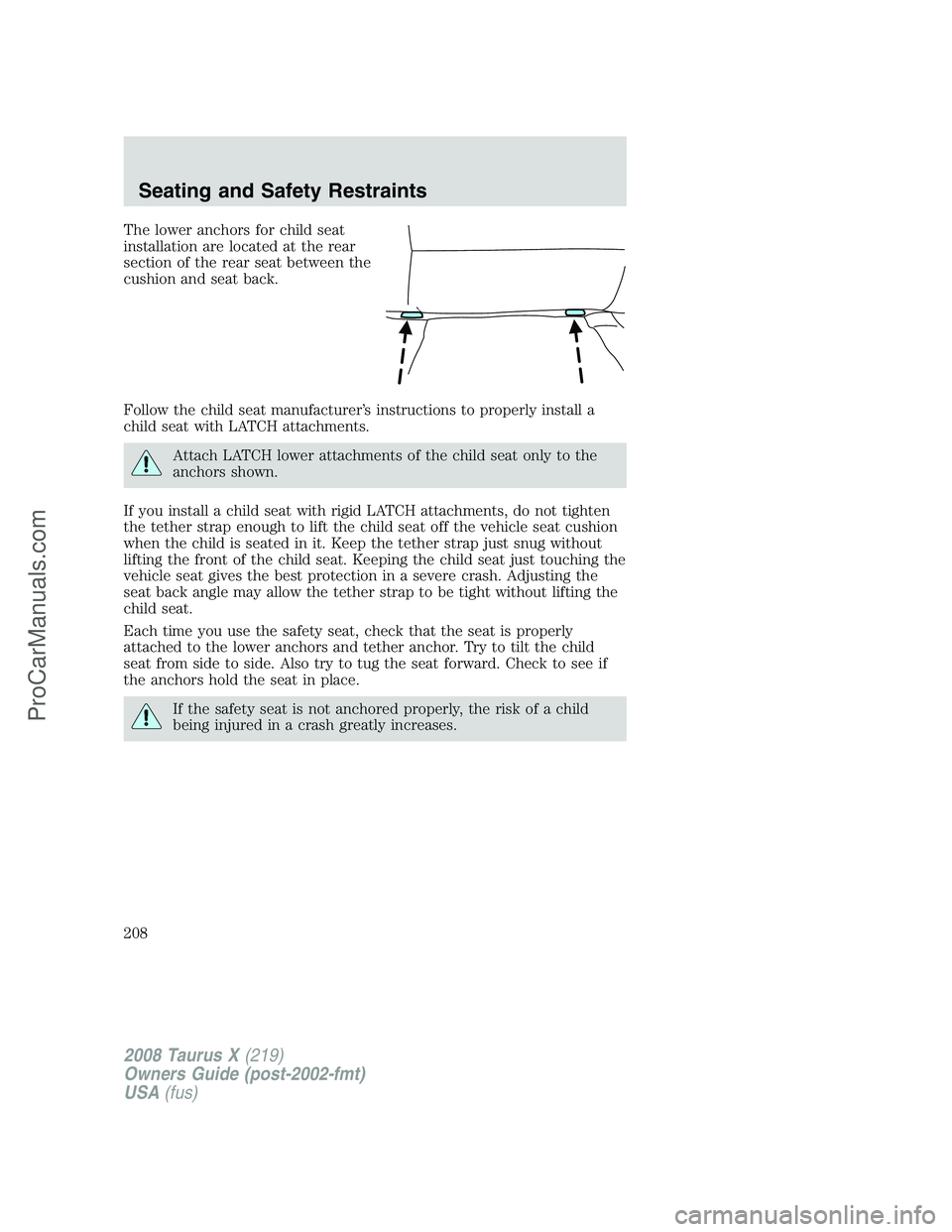
The lower anchors for child seat
installation are located at the rear
section of the rear seat between the
cushion and seat back.
Follow the child seat manufacturer’s instructions to properly install a
child seat with LATCH attachments.
Attach LATCH lower attachments of the child seat only to the
anchors shown.
If you install a child seat with rigid LATCH attachments, do not tighten
the tether strap enough to lift the child seat off the vehicle seat cushion
when the child is seated in it. Keep the tether strap just snug without
lifting the front of the child seat. Keeping the child seat just touching the
vehicle seat gives the best protection in a severe crash. Adjusting the
seat back angle may allow the tether strap to be tight without lifting the
child seat.
Each time you use the safety seat, check that the seat is properly
attached to the lower anchors and tether anchor. Try to tilt the child
seat from side to side. Also try to tug the seat forward. Check to see if
the anchors hold the seat in place.
If the safety seat is not anchored properly, the risk of a child
being injured in a crash greatly increases.
2008 Taurus X(219)
Owners Guide (post-2002-fmt)
USA(fus)
Seating and Safety Restraints
208
ProCarManuals.com
Page 209 of 352
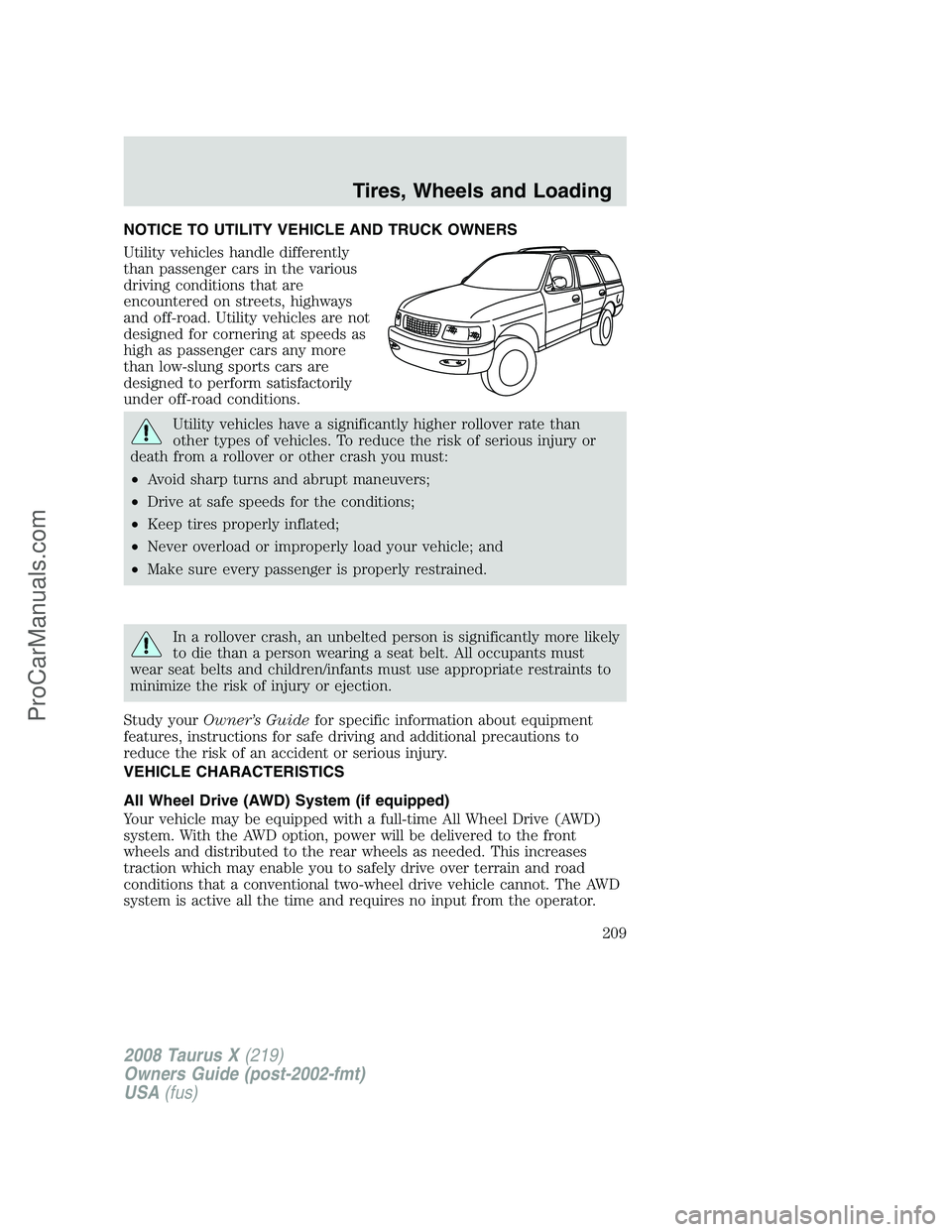
NOTICE TO UTILITY VEHICLE AND TRUCK OWNERS
Utility vehicles handle differently
than passenger cars in the various
driving conditions that are
encountered on streets, highways
and off-road. Utility vehicles are not
designed for cornering at speeds as
high as passenger cars any more
than low-slung sports cars are
designed to perform satisfactorily
under off-road conditions.
Utility vehicles have a significantly higher rollover rate than
other types of vehicles. To reduce the risk of serious injury or
death from a rollover or other crash you must:
•Avoid sharp turns and abrupt maneuvers;
•Drive at safe speeds for the conditions;
•Keep tires properly inflated;
•Never overload or improperly load your vehicle; and
•Make sure every passenger is properly restrained.
In a rollover crash, an unbelted person is significantly more likely
to die than a person wearing a seat belt. All occupants must
wear seat belts and children/infants must use appropriate restraints to
minimize the risk of injury or ejection.
Study yourOwner’s Guidefor specific information about equipment
features, instructions for safe driving and additional precautions to
reduce the risk of an accident or serious injury.
VEHICLE CHARACTERISTICS
All Wheel Drive (AWD) System (if equipped)
Your vehicle may be equipped with a full-time All Wheel Drive (AWD)
system. With the AWD option, power will be delivered to the front
wheels and distributed to the rear wheels as needed. This increases
traction which may enable you to safely drive over terrain and road
conditions that a conventional two-wheel drive vehicle cannot. The AWD
system is active all the time and requires no input from the operator.
2008 Taurus X(219)
Owners Guide (post-2002-fmt)
USA(fus)
Tires, Wheels and Loading
209
ProCarManuals.com
Page 210 of 352
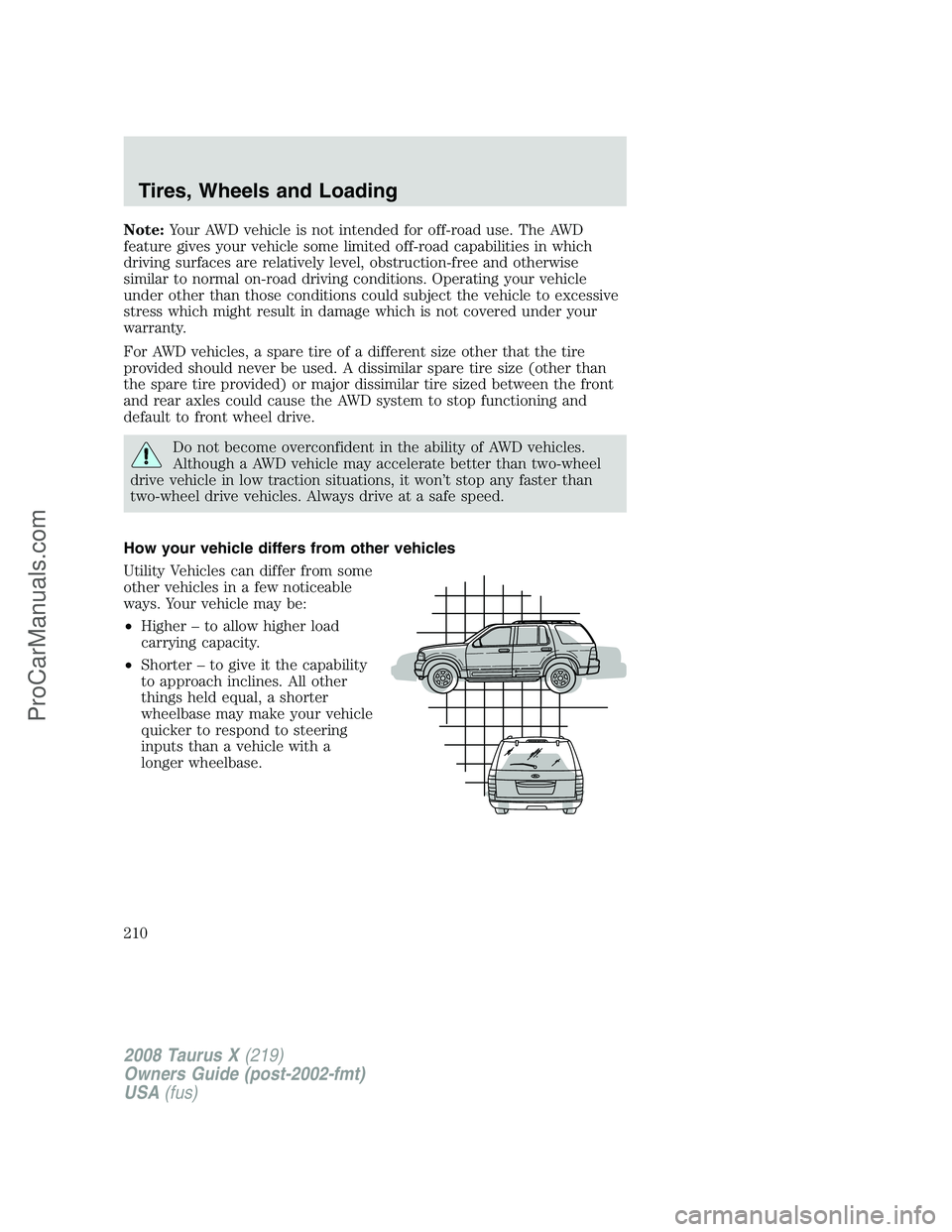
Note:Your AWD vehicle is not intended for off-road use. The AWD
feature gives your vehicle some limited off-road capabilities in which
driving surfaces are relatively level, obstruction-free and otherwise
similar to normal on-road driving conditions. Operating your vehicle
under other than those conditions could subject the vehicle to excessive
stress which might result in damage which is not covered under your
warranty.
For AWD vehicles, a spare tire of a different size other that the tire
provided should never be used. A dissimilar spare tire size (other than
the spare tire provided) or major dissimilar tire sized between the front
and rear axles could cause the AWD system to stop functioning and
default to front wheel drive.
Do not become overconfident in the ability of AWD vehicles.
Although a AWD vehicle may accelerate better than two-wheel
drive vehicle in low traction situations, it won’t stop any faster than
two-wheel drive vehicles. Always drive at a safe speed.
How your vehicle differs from other vehicles
Utility Vehicles can differ from some
other vehicles in a few noticeable
ways. Your vehicle may be:
•Higher – to allow higher load
carrying capacity.
•Shorter – to give it the capability
to approach inclines. All other
things held equal, a shorter
wheelbase may make your vehicle
quicker to respond to steering
inputs than a vehicle with a
longer wheelbase.
2008 Taurus X(219)
Owners Guide (post-2002-fmt)
USA(fus)
Tires, Wheels and Loading
210
ProCarManuals.com